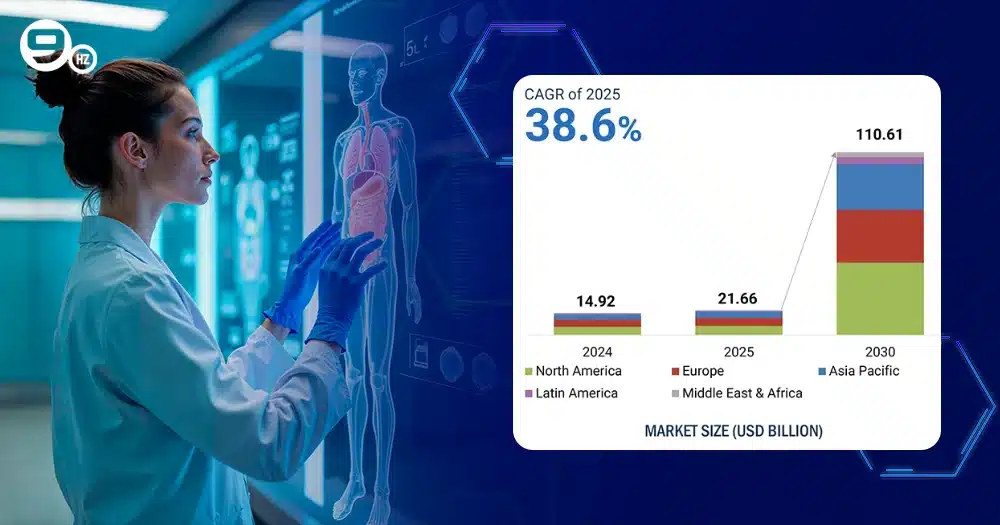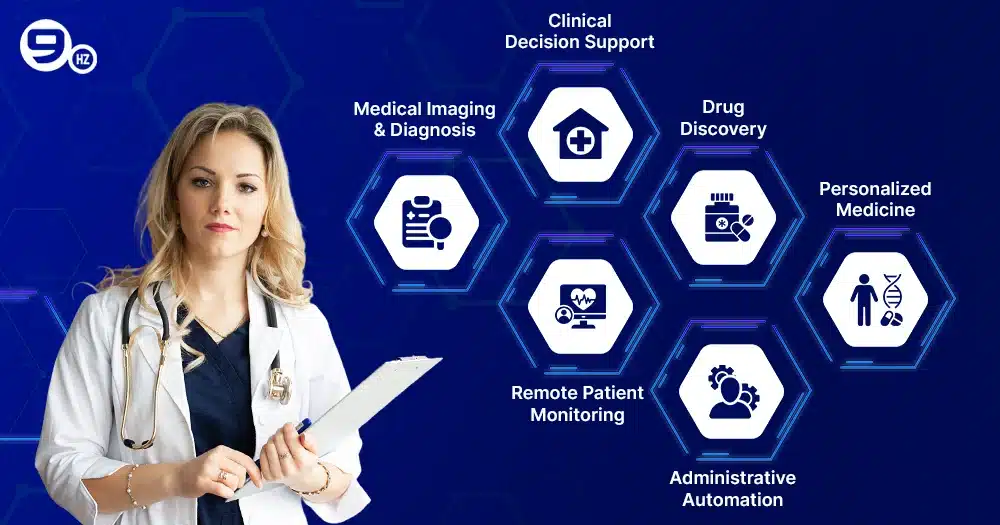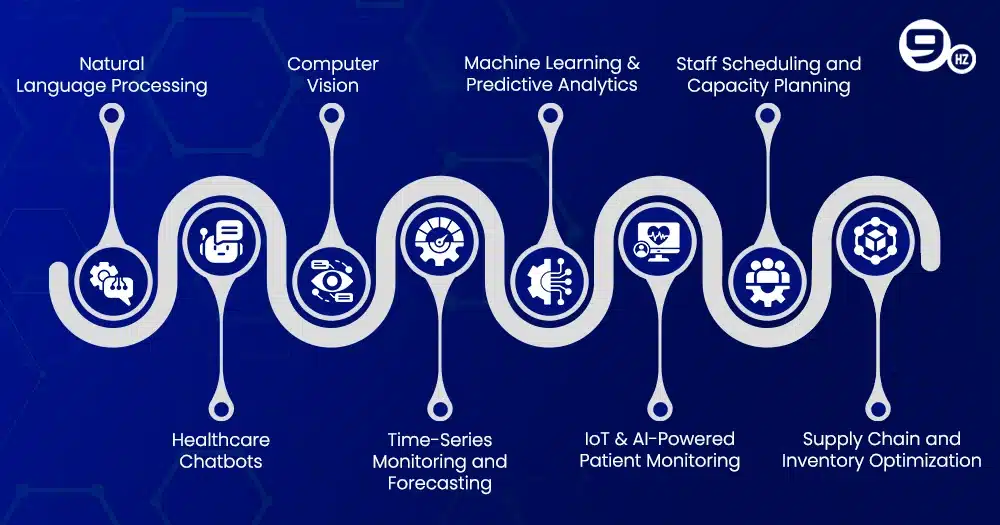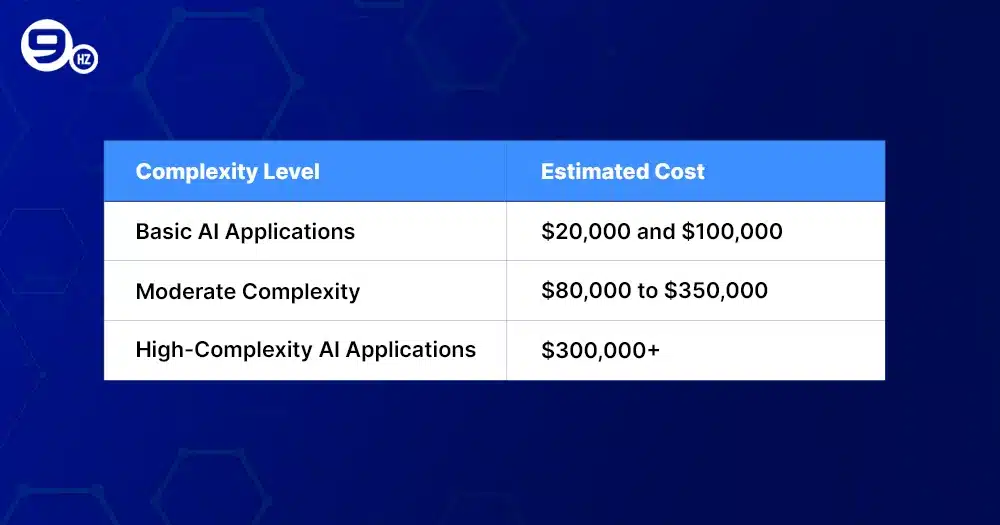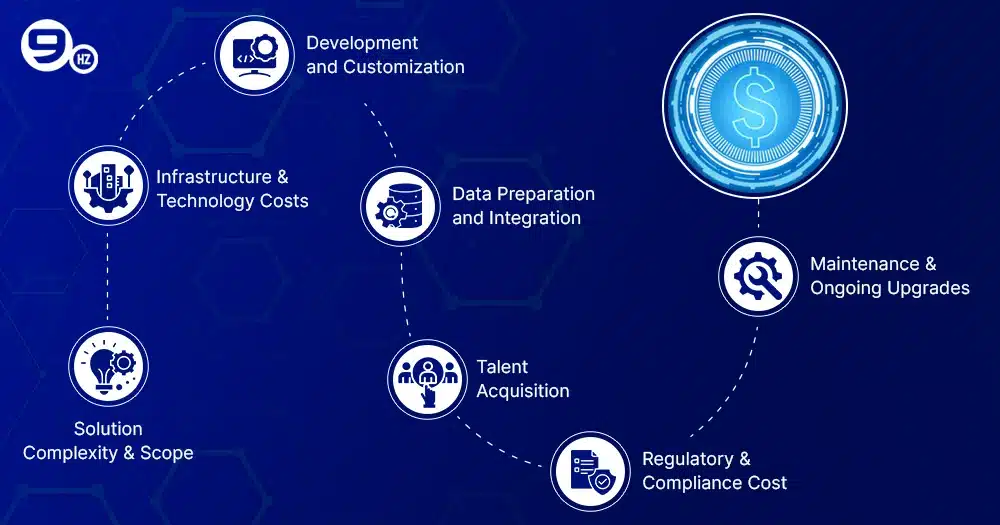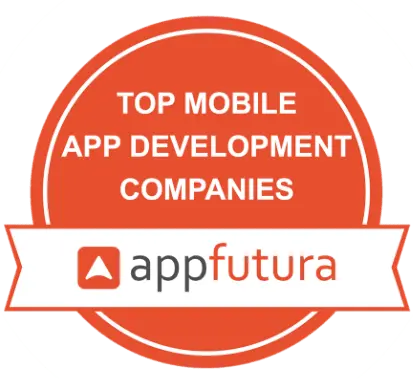Imagine a scenario of a night shift in a hospital where admissions spike. A triage tool spots warning signs in a stream of notes and vitals, pushing the medical team to act sooner.
An AI-powered system can make this happen, and this is the real promise of AI in healthcare, helping people make better calls when it counts. This also explains how the cost of implementing AI in healthcare is about value, time, and safety.
Like other industries, Artificial Intelligence is reshaping the healthcare industry through innovative solutions. With the increasing use cases, the global AI market in healthcare is projected to grow to USD 110.61 billion by 2030, compared to its existing size of $21.66 billion in 2025 and at a CAGR of 38.6% from 2025 to 2030 (Source: MarketsandMarkets), which is quite impressive.
Healthcare and medical businesses are focusing on using AI to improve service quality and bring personalization to the forefront. The key investment areas are drug discovery and precision medicine, medical imaging and diagnostics, workflow automation, and more. But everything comes with a cost. Thus, before making up one’s mind to adopt AI, it is essential to know its implementation cost.
So, the cost varies. Based on research and market stats, the implementation cost of AI in healthcare and medical ranges from $20,000 to $300,000+, depending on the needs, i.e., from a basic solution to a highly complex solution for large-scale operations.
Apart from this, other costs are involved, such as compliance costs. Here, we have created a guide for entrepreneurs like you who are eagerly looking to implement AI for healthcare but know how much it costs. This guide will walk you through all the critical aspects, and by the end, you’ll have all the details.
Let’s continue with the blog!
How is AI Used in Healthcare?
AI has a myriad of use cases in healthcare, from generative AI assistants to appointment booking to AI-powered surgical robots. In contrast, AI is showing up in everyday hospital and clinic work, not just research labs. It helps teams move faster, reduce manual work, and spot risks earlier, which is where the real value comes from.
Let’s have a closer look at the breakdown of applications of AI in healthcare:
1. Medical Imaging & Diagnosis
AI algorithms analyze medical scans from MRIs, CT Scans, and X-rays to help physicians diagnose diseases precisely. In addition to imaging, AI also helps in pathology and dermatology, and improves diagnosis accuracy. 76% of radiology devices in the US utilize AI for diagnosis.
2. Clinical Decision Support
As a surprising factor, 55% of healthcare professionals have already adopted AI in their clinical practices. AI healthcare systems analyze vast patient data and provide evidence-based recommendations for better patient care.
3. Drug Discovery
AI can help in the rapid identification of new treatments, therapies, and drugs, including safety and preventing side effects, to enhance healthcare for common people. The algorithms are capable of screening molecular compounds that a Pharmaceutical company can utilize to innovate medicine for a better future for mankind.
4. Personalized Medicine
Healthcare professionals employ AI for personalized medication, as it provides a deeper understanding of patients’ responses to medicine based on genetics. For example, oncologists use platforms such as Tempus, which offer personalized suggestions based on a patient’s history.
5. Administrative Automation
AI automates administrative processes such as clinical documentation and record-keeping, and saves healthcare professionals time.
6. Remote Patient Monitoring
Combining AI with IoT, healthcare professionals are leveraging it for remote patient monitoring, especially for those with health issues such as cardiac, diabetes, and cancer.
Key Statistics That Show the Growth of AI in Healthcare
Before we dive deeper into the blog to learn more about the cost of using AI in healthcare, let’s explore some exciting statistics. It will help you gain a quick understanding of the industry and trends.
- Based on a survey report published by McKinsey, 85% of respondents, including healthcare leaders, investors, and HST(healthcare services and technology), had already adopted gen AI for healthcare, and the growth graph will increase in 2025.
- According to Global Market Insights, the AI healthcare market will be worth $431.05 billion by 2032.
- AI in the healthcare diagnostic market is expected to be worth $35 billion by 2027, and by 2028, AI-driven remote patient monitoring is projected to generate annual savings of $200 billion for the healthcare industry.
- In another report published by a trusted market research-based company, in the USA, 65% of hospitals already employed AI-powered predictive models for high-risk outpatient identification, inpatient trajectory prediction, and scheduling.
- Worldwide, North America dominates in implementing AI in the healthcare market, with a revenue share of 54%.
8 Types of AI Applications Transforming the Healthcare Industry
Earlier in this blog, we explored how AI is used in healthcare, such as imaging and diagnosis, drug discovery, personalized medication, and more. Now, let’s examine practical applications of AI.
1. Natural Language Processing
Documentation, care coordination, and patient communication are integral to standard healthcare practices. All these activities happen using natural language or regional language. Sometimes, this creates an issue in managing unstructured text, such as clinician notes, referrals, and patient messages, especially on a large scale. Here, AI and its subset, Natural Language Processing, help turn all the data and communication into a clean summary and speed up the clinical documentation process.
For example, speech-to-text detection and data entry.
2. Healthcare Chatbots
Healthcare chatbots are gaining rapid popularity, and their market is experiencing robust growth. The global healthcare chatbot market is projected to surpass $7.09 billion by 2034. How do healthcare chatbots improve healthcare? These chatbots help with symptom checking, appointment scheduling, medication management, and chronic disease management.
One of the real-life examples is the Cleveland Clinic Assistant, which is an IBM Watson-powered healthcare chatbot.
3. Computer Vision
AI-powered computer vision analyzes medical images to flag likely findings, accurately diagnose disease, measure change, and aid in treatment planning. It helps radiologists for early detection of chronic diseases(such as cancer, tumors, and retinal diseases), automated monitoring, cellular image analysis for drug discovery, and provides surgical assistance with real-time imaging.
4. Time-Series Monitoring and Forecasting
These models track data over time, like heart rate, ward census, or appointment patterns. They power bedside alerts, warn when a patient worsens, and predict busy hours. The key benefits are early warning and better resource use. These applications work on live data feeds, making the system respond fast and check often as patterns change.
5. Machine Learning & Predictive Analytics
Machine Learning, as a subset of AI, has a great application in healthcare and medicine. It helps analyze large and complex data obtained through diagnosis, EHR, imaging, and even from visits and labs.
Predictive analytics, in combination, identifies patterns using data and can forecast epidemic outbreaks, help in resource optimization, and more. For example, machine learning and predictive analytics help in hospital readmission prevention, early disease detection, resource optimization, and enhancing operational effectiveness.
6. IoT & AI-Powered Patient Monitoring
IoT and AI-powered remote patient monitoring systems collect data through wearables, analyze patterns, and send alerts to the medical team in case of an emergency. As a benefit, there are fewer avoidable ED visits and better control of chronic conditions. From the perspective of the cost of implementing AI in healthcare, the cost involves device integration and network setup.
7. Staff Scheduling and Capacity Planning
AI-driven staff scheduling tools use forecasting to predict patient load by hour and unit, then suggest rosters that meet staffing ratios. Critically, these tools also identify gaps and help hospital administration manage their human resources effectively to provide better care services even during emergencies and rushes.
8. Supply Chain and Inventory Optimization
AI forecasts demand for consumables and high-value items, sets reorder points, and reduces stock-outs and waste. It can also detect price anomalies and suggest vendor alternatives.
What Is the Average Cost of Implementing AI in Healthcare?
The central theme of this article is how much it costs to implement AI in healthcare. The fact is that budget varies a lot because no two healthcare businesses have the same needs. On average, developing and deploying an AI solution can cost anywhere between $20,000 and $300,000. In simple terms, it depends on scope, complexity, features, and integrations like EHR or PACS. So, let’s have a look at the cost based on common or complexity basis, i.e., basic, moderate, and high complexity. Consider these as ballpark estimates, not the actual costs or quotes.
1. Basic AI Applications
Think of a patient FAQ chatbot, a simple feature that extracts allergies from notes, or a triage helper for portal messages. These are all basic AI applications for healthcare built on narrow and simple requirements. Consider these tools for simple requirements, such as small clinics, where use cases are appointment scheduling, patient reminders, virtual healthcare chatbots, or triage assistants helping patients and clinicians get better care.
If you have a question, why is the cost lower?
The programs are less complex, need less data to learn, and often fit more easily into the systems you already have.
Est. cost: $20,000 to $100,000
Cost Breakdown
- CapEx: $20,000-$80,000 for design, development, and licensing
- OpEx: $1000-$20,000 for cloud hosting, support, maintenance, and upgrades.
2. Moderate Complexity
Diagnostic support systems, predictive analytics, virtual nursing assistants, AI for medical coding, and medical billing automation are examples of moderately complex AI-powered healthcare solutions.
In contrast, these moderately complex solutions are a bit more advanced than basic AI applications. These projects involve smart algorithms that improve patient care and help healthcare businesses, such as mid-sized hospitals, achieve operational efficiency.
The cost is high here because these solutions require high-quality and vast patient data for the AI to train on, and they need more work to connect appropriately with the hospital’s EHR/EMR systems.
Est. Cost: $80,000 to $350,000
Breakdown
- CapEx: $40,000-$300,000 for design, custom healthcare software development, and licensing.
- OpEx: $1000-$50,000 for hosting, support, maintenance, regular updates, data management, data cleaning, and refinement.
3. High-Complexity AI Applications
The simplest example of a highly complex AI solution is full AI integrations across departments or a chain of hospitals using AI for everything from patient handling to medical research. These solutions require massive computational resources, infrastructure, hardware, and extensive regulatory approval.
These solutions can be precision medical platforms, software for AI-assisted robotic surgery, drug discovery, clinical trial optimization, or hospital-wide automation. From a features perspective, high-complexity AI applications for healthcare contain all the features of basic and moderate AI solutions, including their own unique features.
The cost of implementing AI in healthcare in an advanced way increases due to the involvement of cutting-edge AI algorithms such as Deep Learning, Generative AI, Artificial Neural Network(ANN), GPU clusters, and approvals like the FDA.
Est. Cost: $350,000+
Cost Breakdown
- CapEx: $300,000+ for design, custom AI algorithm development, high-end hardware, GPU clusters, multi-departmental integrations, security implementation, and regulatory submission.
- OpEx: $1000-$50,000 for hosting, support, maintenance, regular updates, data management, data cleaning, and refinement.
| Complexity Level | Cost |
|---|---|
| Basic AI Applications | $20,000 and $100,000 |
| Moderate Complexity | $80,000 to $350,000 |
| High-Complexity AI Applications | $300,000+ |
The above represents the cost of AI in healthcare based on complexity.
Let’s see the cost based on AI applications.
1. Generative AI/ LLM for Healthcare Implementation
Integration of Generative AI or LLMs (large language models) in healthcare offers significant benefits, and a ballpark estimate for its implementation ranges from $50,000 to $150,000 or more. Basic implementation may take 3-6 months and cost $20,000 to $40,000+, while more advanced applications, such as patient triage and automated documentation, can range from $150,000 to $250,000+.
2. Predictive Analytics/ ML Models Implementation Cost
The average cost of implementing AI for predictive analytics or ML models can be $100,000-$200,000, and examples of solutions include clinical workflow automation, patient risk prediction tools, early disease detection, and hospital operations and resource optimizations. Basic models may cost around $35,000–$50,000, while more advanced ML models typically range from $100,000 or more.
3. Computer Vision/Medical Imaging Implementation Cost
Although implementing an AI-powered medical imaging system requires a significant investment, it’s worth it. The cost varies based on numerous factors, from features and complexity to the chosen tech stack. Basic image analysis AI tool costs $40,000-$60,000, complex medical imaging interpretation can cost $100,000-$200,000, and a highly advanced medical imaging system can cost $250,000 or more.
4. Custom Deep Learning Solutions for Healthcare Cost
Custom Deep Learning (DL) solutions in healthcare are complex AI applications and require high investment. You can expect the cost to start around $200,000, and it often goes over $300,000. While basic projects can start at $50,000–$150,000, they frequently do not lead to clinically deployable outcomes. Despite these expenses, custom DL solutions have significant potential to transform diagnostics, personalize medicine, and enhance operations. The custom solutions provide superior customization and performance.
5. Drug Discovery Implementation
A basic setup that analyzes public datasets and supports small screens can cost approximately $75,000 to $120,000+. Adding proprietary data, lab system links, and active learning lifts budgets to $150,000 to $300,000. Enterprise platforms with large libraries and GPU clusters often exceed $300,000.
6. Remote Patient Monitoring Using AI
The average cost of implementing AI for remote patient monitoring can range from $50,000 to $300,000 or more (depending on requirements). For example, simple software, adding one condition, and integrating a single device and a simple dashboard can cost $50,000-$60,000, but the budget will increase if you want to add multiple conditions, alert tiers, and more devices.
7 Major Factors That Influence the Cost of AI Implementation in Healthcare
It is also your right to know what factors affect the implementation costs to make a perfect decision about implementing AI for healthcare. The cost figures you saw in an earlier section are just ballpark estimates, and the factors we are going to read about now are the actual actors behind the scenes.
1. Solution Complexity & Scope
Scope and complexity are two of the most significant cost-determining factors in implementing artificial intelligence in healthcare. The concept is simple- the more complexity, the more cost.
Simple AI chatbots development costs $20,000-$50,000, such as for a small clinic, but if you need an advanced solution, e.g., diagnostic imaging, predictive analytics, drug discovery, an AI system for early disease detection, or more, it may cost $100,000 or more.
Why are large-scale and highly complex solutions expensive? Because the implementation of large-scale projects requires high-end infrastructure and technology.
2. Infrastructure & Technology Costs
Basic systems can run with simple resources, but if you need an advanced system, you also need high computational resources, which increases the cost. What comprises infra cost? These include hardware costs, software and licensing costs, and system integration costs.
For example:
- An On-prem GPU server with A100S costs about $20,000 to $100,000, and mid-GPU clusters cost $120,000 to $200,000 (hardware only).
- Cloud GPU: roughly $3,000 to $4,000 per month for basic, up to $30,000 to $40,000 per month for heavy training nodes.
This is just about the hardware costs. An annual fee ranging from thousands of dollars is also associated with software and licensing.
The third component is the system integration fee. Suppose you want to integrate your custom solution with EHR/EMR systems. This can add 20–30% to the total infrastructure cost and may require developing custom APIs.
3. Development and Customization
An off-the-shelf solution can save you money, but it doesn’t guarantee alignment with your requirements, as these solutions work on a fixed framework and are built on predefined requirements. On the other hand, custom AI healthcare software development ensures the full fulfillment of your business’s needs and alignment with your goals.
This increases the cost by up to 30-40% over off-the-shelf solutions, but the results will be tremendous. The average cost to develop a custom solution initially ranges from $20,000-$350,000; the rest depends on your requirements.
Tip: For an exact cost estimation, contact an experienced artificial intelligence development company with a proven track record in providing healthcare solutions. The experts will not only help you estimate the cost but also provide a strategic development roadmap.
4. Data Preparation and Integration
AI systems work on data, which must be clean to make the model useful. If notes, images, and codes are messy, you pay in delays and rework. It is costly to obtain, clean, and integrate the data, and it may cost you up to 60% of the total AI project budget [McKinsey Report].
For example, MIMIC-III labeled data for critical care, and if you want to use it, the purchase cost and institutional partnership are required.
Tip: Synthetic data or automated labeling can help you mitigate the expenses.
5. Talent Acquisition
One of the core requirements for developing a robust AI-powered healthcare application or software is an experienced team. The team comprises cross-functional experts such as data scientists, ML engineers, developers, MLOps specialists, designers, testers, and project managers. The hiring cost depends on expertise.
For example, full-time developers in the US typically earn $80k to $150k per year, project managers earn over $120,000 per year, and data scientists earn around $100,000+ per year. Thus, their hiring cost is accordingly increased with experience. Hiring experts increases the budget, and you need to plan accordingly.
Tip: Outsourcing your project to an experienced healthcare app development company can help you save costs and bring value to your project.
6. Regulatory & Compliance Cost
Compliance is crucial for patients’ security, trust, and following the laws and regulations. Ensuring HIPAA, GDPR, or regional regulatory compliance, plus data privacy and cybersecurity, typically adds $10,000–$30,000 or more to project budgets. It will also help you to follow the global healthcare industry’s legal framework.
7. Maintenance & Ongoing Upgrades
Maintenance and upgrades ensure the longevity of the system and keep things seamless, not only in terms of execution but also in terms of security and compliance. It recurs 15-20% of the overall project cost and involves tasks like model retraining, performance tuning, system updates, feature upgrades, security enhancements, and more.
7 Benefits of Implementing AI in Healthcare Systems
Implementing AI in healthcare offers several benefits for all, i.e., Patients, Healthcare Professionals, and service providers. These include:
1. Better Administrative Workflow
Doing administrative work and handling paperwork are one of the hurdles and repetitive tasks for healthcare professionals. Here, AI helps them to save time and effort. Example- Generative AI helps professionals in taking notes, content summarization, and reducing paperwork when handling patients’ reports and data.
2. Round-the-Clock Assistance
Virtual nursing assistants help patients access healthcare services, medication guidance, report forwarding to the doctors, and more. This makes the availability of services for the patients 24/7 and expands their reach for better care. One of the finest examples is an app like Babylon.
3. Personalized Medicine
AI systems are capable of recommending medicine and dosage based on the genetics and the patient’s history. It leads to personalized medication, dosage error reduction, and fewer side effects.
4. Better Communication
83% of patients report poor communication as the worst part of their experience[IBM], and that’s true because, for better care, communication is necessary. NLP, predictive analytics, speech recognition, and AI-driven speech-to-text make communication smooth and lead to improving the healthcare user experience.
5. Cost Reduction and Efficiency
AI applications help in cost reduction by automating administrative tasks, billing automation, resource optimization, demand forecasting, and reducing misdiagnoses.
6. Better Resource Management
Predictive analytics in AI facilitates more precise hospital staffing, the efficient utilization of medical resources, and a more seamless patient flow, thereby further reducing costs and enhancing service quality.
7. Support for Preventive and Proactive Care
AI identifies patients at risk of developing chronic diseases through analyzing medical imaging, lab test results, and symptom summaries provided by patients, which enables early intervention, prevention, and lower long-term costs.
ROI Analysis: Is Implementing AI in Healthcare Worth the Cost?
AI is reshaping the healthcare industry, healthcare practices, and the way healthcare service providers operate. AI in healthcare is helping to improve proactive care, patient access, personalized medication, streamline administrative workflows, early disease detection, and optimize clinical decision-making. Despite the fact, does AI deliver a positive return on investment (ROI)? Or is AI worth the investment? Most of the business owners ask this question, and that is valid.
Investing in implementing AI in healthcare offers financial benefits such as cost reductions, increased revenue, and operational efficiency.
Let’s understand first how it helps in cost reduction through examples.
- Administrative Tasks- Automating tasks like billing, scheduling, or record keeping.
- Billing & Claims- Quickly check medical codes and insurance claims before submitting them.
- Re-admission Penalties– Predictive analysis of patients prone to re-admission soon after discharge.
- Diagnostic Errors– AI-assisted imaging helps doctors detect diseases, such as small fractures or early cancer signs, with accuracy.
Impact: Staff spend less time on paperwork, reducing labor costs and freeing up employees to focus on patient care.
Impact: Reduced numbers of rejected claims, improved cash flows, and reduced efforts to keep the process authentic and fair.
Impact: It helps healthcare professionals intervene early, reducing re-admissions and avoiding government penalties.
Impact: reduced chances of late-stage treatments and avoidance of misdiagnosis of diseases.
It’s okay that AI in healthcare brings great ROI, but how does it actually help in terms of revenue?
The concept is simple: more patience, more revenue. How? Suppose, if a doctor is using an AI healthcare assistant and virtual scribe, then it automates the note-taking and documentation process, saving the time of doctors, and they can see more patients than they were not able to do traditionally.
AI also helps in resource management, such as overstaffing (wasting money), understaffing (losing revenue from turning patients away), and demand forecasting for equipment to provide better care to the patients.
To reach more patients, with the help of AI, hospitals or healthcare businesses can offer new services such as advanced risk-prediction programs and more.
Now, let’s understand it mathematically!
The formula to find ROI is: Net Return/ Cost of Investment.
Let’s break it!
Suppose A hospital invests $300K in an AI, an advanced disease prediction tool. The annual savings from avoided ICU stays are $500k, the yearly maintenance cost is $50k, and the net annual benefit is $450k. So, the 3-year ROI would be like:
Net Return: [($450K × 3) – ($300K + $150K)], and the total cost would be ($300K + $150K), so the ROI would be around 200%.
This is just a hypothetical example. Is there any real example?
Yes, they are in multiples.
British Heart Foundation is leveraging Microsoft 365 Copilot for communications, draft reports and emails, summarizing meetings, and long documents. As a result, it saves organizations time up to 30 minutes per person per day, including lower cognitive load and faster handoffs.
The truth is, investing in AI is not just spending; it’s a smart investment for better care, reducing stress on staff and professionals, cost savings, and a better future for the healthcare industry.
Real-World Examples of AI Applications in the Healthcare Industry
AI in healthcare is not a theoretical concept, and now, investments in AI are driving real results across hospitals, labs, and research centers. Below are some real-world examples of AI applications.
- Cedars-Sinai is a non-profit healthcare organization (founded in 1902) that is using CS Connect, an AI-powered virtual platform that lets patients access healthcare support 24/7, and by 2025, it has delivered 24/7 care to 42,000 patients successfully.
- Omega Healthcare is one of the top global revenue cycle management companies and helps 350+ healthcare organizations manage financial operations. Partnering with UiPath, the company implemented AI-powered document automation and saved 15,000+ hours per month, reduced turnaround time by ~50%, and attained 99% accuracy in documentation.
- Recently, China’s tertiary hospitals adopted DeepSeek as an AI system nationwide for enhancing diagnostic accuracy, streamlined workflow, imaging analysis, and more use cases.
- Mayden, one of the healthcare giants of the UK, adopted an AI-powered healthcare solution, IBM Instana, and to date has served 5+ million patients, having software updates up to 4 in a week, accelerating incident triage and AI-assisted root-cause analysis for better healthcare and mental care services to the patients.
- Kheiron Medical Technologies, in partnership with NHS Grampian and the University of Aberdeen, has launched Mia, an AI breast screening solution utilizing Azure Cloud Services, which has achieved a 12% increase in breast cancer detection, facilitating earlier interventions.
5 Challenges and Risks of Implementing AI in Healthcare
AI brings promise, but it also has challenges. From the business owner’s perspective, it is crucial to understand the challenges, too. Later, it will help you make the right decision and make a strategy to ensure the success of the implementation of AI in healthcare.
1. Data Privacy and Security
AI systems depend on vast amounts of data, such as patient data, medical records, and even research data. Safeguarding that data from cyberthreats and unauthorized use is a significant challenge for healthcare businesses. A small breach can create a big blunder and cause serious damage to patient trust and hospital reputation.
Solution
Implementation of strong data encryption, multi-level access controls, and following privacy laws like HIPAA or GDPR are the best solutions to the data security challenge.
2. Integration Challenges
Large-scale hospitals or clinic chains use complex tools such as EHRs and billing software. Connecting new AI systems to these can slow down operations or make it challenging due to legacy systems.
Solution:
As a solution, it would be best to start with trial projects. Test AI systems at a small but practical level before rolling them across the organization. Upgrade your existing systems before integration with AI-powered healthcare solutions.
3. Budget & Implementation Cost
Organizations want to adopt Industry 4.0 solutions, but are not aware of the actual budget required or the cost to implement AI in healthcare. Or, Hospitals want to invest but are not sure about ROI.
Solution
The best solution to figure out the exact cost estimation is to take the help of an AI development company experienced in providing solutions such as an AI chatbot, healthcare software, and more. Aligned to your requirements, experts will help you with an exact cost estimation and plan the project in small phases.
4. Bias and Accuracy Problems
AI models can show bias if they are trained on limited, unprepared, and skewed data. This can affect diagnosis quality, lead to unequal care, and other issues, even in extreme cases of racism-biased treatment.
Solution
Use diverse datasets and update them regularly, deploy human experts to review AI decisions, especially in the early stages, and consistently test the system to ensure its accuracy and fairness.
5. Regulatory and Ethical Concerns
Although AI is evolving fast, there are still some regulatory and ethical concerns associated with it.
Solution
The only solution is adhering to compliance with local and international AI regulations. You can also take assistance from legal experts for legally using AI for the betterment of society through authentic healthcare practices.
How to Choose the Right AI Model for Your Healthcare Use Case?
Off-the-shelf solutions rarely fit the diverse needs of healthcare organizations, as each operates with its own unique goals, challenges, and workflows. The requirements are different for each one, so the AI model must be adjusted accordingly. Want to know how to choose the right one? Here are the steps to follow:
1. Define Your Goals
First, define for what purpose you need AI, such as for medical image analysis, early disease detection, personalized medication, or automating hospital workflow. A clear goal will pave the path to the right solution and cover half of the journey.
2. Know Your Data
Data is fuel for AI models, so before you make any move, know and understand your data first. If your data is incomplete, outdated, or biased, it may lead to disaster, and you’ll end up with nothing or just a wastage of money.
3. Check Compliance and Security
The healthcare industry is tightly bound by compliance, such as HIPAA, GDPR, or local privacy laws, and the models store data differently from each other. So, before choosing an AI model for your healthcare use case, ensure it complies with regulations.
4. Evaluate Performance Metrics
Before adopting the AI model, evaluating its performance based on metrics such as accuracy, sensitivity, specificity, AUC, calibration, and fairness is good practice. Also perform internal and external validation to check the model’s robustness and ensure accurate outcomes.
5. Consider Integration and Scalability
Also, check the integration capabilities and scalability of the model before you adopt it. It often happens that integration creates issues, especially when you use legacy systems. Therefore, always choose a model that can be seamlessly integrated with existing EHRs, hospital databases, and workflows.
Once you find a satisfactory answer, don’t forget to give it a trial run and deploy it as a pilot project. It will help you analyze the performance and take perfect measures to deploy it on a large scale.
How can The NineHertz Help You implement AI in healthcare?
The NineHertz, as a trusted AI development company, specializes in developing affordable and scalable AI solutions for the healthcare industry. We help hospitals, clinics, and startups simplify complex challenges through automation, data intelligence, and predictive insights. Our expertise covers every stage of AI implementation, i.e., from identifying the right opportunities to deploying solutions that fit real-world medical needs.
Over the years, we have built a strong reputation for delivering cost-effective AI innovations by combining technical precision with deep healthcare understanding. This makes us your ideal partner and the right choice for developing smart, secure, and high-performing AI solutions that truly transform patient care.
Conclusion
By now, you have a clear idea of what it takes to implement AI in healthcare, the real costs, the expected returns, and the challenges to prepare for. This complete guide will not only help you have an idea about the cost, but also help you choose the best model suited to your use case.
The average cost ranges between $20,000 – $350,000, approximately, and it can go higher. But consider it worthwhile for the future of your business. It will add more value to your business with careful planning.
As an experienced AI-powered healthcare solutions provider to the global healthcare brands, our industry experts can assist you from ground zero planning to deploying the AI solution, saving cost but enhancing the value. We’re open to discussing your idea and solving pain points through our expertise. So, when are you planning to embrace AI for the healthcare business? Let us know!
Frequently Asked Questions (FAQs)
How Much Does It Cost to Implement AI in Healthcare?
Actually, it depends on your needs. Suppose, if you need a simple appointment booking chatbot, it may cost you $20,00,0, but if you need an advanced system powered by AI, Machine Learning, and Natural Language Processing for use cases like predictive analytics, medical imaging, drug discovery, or more, it may cost you $350,000 or more. For more details, you can connect with us anytime.
What Are the Hidden Costs in AI Implementation?
The hidden costs involved in AI implementation are:
- Data acquisition, preparation, and cleaning
- Talent acquisition and training
- Integration costs
- Compliance fees
- Maintenance and model retraining
- Downtime and transition support

